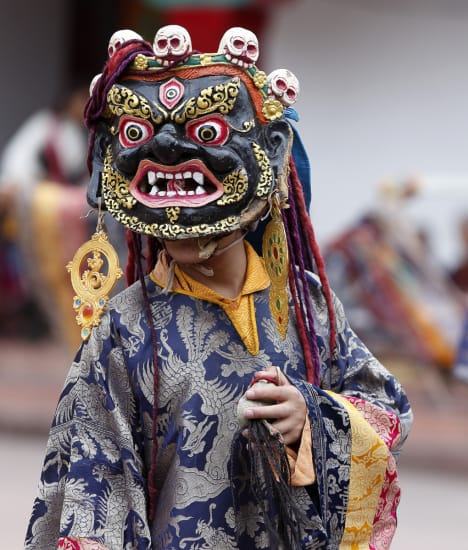In Step With Culture: Experience The Vibrant Chaam Of Sikkim
A celebration of faith and devotion, the ritualistic dance of Chaam reveals itself as an important aspect of Sikkim’s heritage
Nestled within the breathtaking vistas of the Himalayas, the state of Sikkim is a land of verdant mist-laden peaks and cascading waterfalls. It is here that a unique festival of dance awaits your discovery. The vibrant tapestry of Chaam, a ritualistic dance and an epitome of Sikkamese culture, never fails to enthral.
Held according to the Tibetan calendar, Chaam dances are one of the most colourful celebrations that take place in the courtyards of Buddhist monasteries as part of a bigger festival. Chaam dances have a long history, dating back to the time of Guru Padmasambhava, the founder of Tibetan Buddhism in Sikkim, who is supposed to have done this dance to expel a demon from this holy place.
 The Chaam dance festival attracts pilgrims from far and wide. Picture: Shutterstock
The Chaam dance festival attracts pilgrims from far and wide. Picture: Shutterstock
What sets this dance apart is the use of vibrant masks and colourful costumes through which performers embody different characters ranging from the divine to the devil. Their movements, a seamless symphony of grace and power, tell the tales of ancient legends and spiritual teachings, and have the power to transport onlookers into a realm where we speak with God.
Yak Chaam: Yaks are an intrinsic part of Himalayan life; to celebrate their contribution to our lives, performers wearing costumes and masks resembling the yak stampede through the courtyard and fill the space with an infectious energy. It is believed that honouring the yak brings good fortune and wards off evil from the land.
 Chaam is a ritualistic masked dance that is held in monasteries. Picture: Shutterstock
Chaam is a ritualistic masked dance that is held in monasteries. Picture: Shutterstock
Drag-dmar Chaam: Held in the Pemayangtse monastery in west Sikkim, the Drag-dmar chaam sees mask-dances performed on the first two days of a festival that marks the end of one year and the beginning of the Tibetan New Year. Lamas from the monastery dress up as Mahākāla and Guru Drag-dmar to engage in a mock battle that signifies victory of good over evil. On the last day, a giant embroidered Buddha-scroll (Thankga) is displayed at the monastery.
 Chaam is marked by elaborate masks and costumes. Picture: Shutterstock
Chaam is marked by elaborate masks and costumes. Picture: Shutterstock
Kagyed Chaam: Kagyed is another type of chaam, performed by Buddhist monks and lamas to honour the divine and ward off evil. This festival, mostly held in December, is most popular in the monasteries of Lingdum (Ranka), old Rumtek, Enchey and Ralang, and attracts hundreds of believers who hope to be blessed by witnessing the masked dance. Observed with offering prayers followed by the ritualistic Lama Dance, this chaam is performed to impress the Kagyed deities.
*These masked dance festivals are held at different dates each year in different monasteries across the state, so it is always better to check the official tourism board website before including it in your itinerary.












